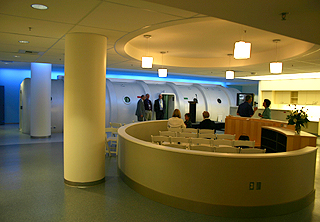
DJC.COM
August 25, 2005
Reaping the benefits of better design
Clark/Kjos Architects

Frum
|
As health care architects we have noticed a trend over the past few years: health care organizations, after applying quality-improvement methods, are opting to upgrade their facilities.
These methods are known by various names such as "Rapid Improvement Process," "Lean Enterprise," "Keizen," "Six Sigma," and so on. They all aim at improving processes by maximizing resource use while minimizing waste. The improvement processes are often run by a consultant or by in-house personnel with similar expertise.
Pressed for performance
Health care organizations have been experiencing a financial squeeze for a while.
On one hand, their income is stagnant as a result of (almost) fixed reimbursements from government and insurers. On the other hand, expenses keep rising as a result of inflation, amortization and new (more expensive) treatments and technology.

Photo by John Ryan
Virginia Mason Medical Center held a workshop to explore ways it could increase the number of patients it treats in its 40-foot-long hyperbaric chamber. The hospital added dressing, toilet and treatment space, allowing some patients to prepare while others are being treated.
|
This scenario leaves such organizations with only one way to improve their bottom line — increased efficiencies. As a result, many health care organizations are turning to improvement methods, developed by other industries, to help them improve.
How design affects quality
What we find most intriguing about this trend are the similarities between our own architectural methods — namely, programming and design — and the process-improvement methods.
Improving the functions and the relationship between functions is endemic to how we approach programming and design. Improvement in quality should, therefore, follow good design.
There are several ways that good design improves hospital quality:
— Simplifies processes by locating functions to respond to the most efficient progress. The staff define their best processes, and architects place them so the staff can proceed though them smoothly.
— Shortens distances between various functions. Staff often go to the same space dozens of times per day — shortening that trip even one foot can make a difference of hours saved over a year, saving staff fatigue and costs.
— Standardizes the design, allowing the staff to adapt to their environment more quickly. Standards include using the same layout for rooms of the same purpose, or organizing cabinet supplies the same way. This speeds the staff's ability to respond to their patients and avoid errors in the process.
— Shortens stays and improves outcomes (and bottom lines) using "evidence-based design" techniques. These include proven methods such as single-patient rooms and natural lighting in patient spaces.
— Prevents staff injuries with good ergonomics, avoiding health-related absences. It also improves patient comfort. This becomes particularly important as the median age of health care workers keeps climbing.
Hospitals apply lessons
Many of these techniques are commonplace in health care design. They're often incorporated into projects even when these projects have not gone through a formal quality-improvement process.
The following examples illustrate the correlation between quality improvement and design, both with and without formal processes:
— The Seattle Children's Hospital and Regional Medical Center noticed that they were not following patients closely through their exams and assessments. Because staff were concentrated in one area it was not clear which staff members were responsible for which patients.
The outcome of their quality-improvement process was to split up the department into sub-groups based on the acuity level of the patients. The design allowed the department to function in its new format within its existing space.
— Virginia Mason's hyperbaric medicine department treats groups of patients in its pressurized chamber for two hours at a time. A rapid-improvement workshop explored ways that the department could increase the number of patients it treats.
A two-pronged solution was applied by increasing the number of dressing and toilet spaces and duplicating the treatment space, allowing a group of patients to prepare while the others are being treated.
— Children's Hospital's central sterile department is responsible for sterilizing the surgical equipment.
When the department decided to replace its equipment, it used the opportunity to improve its physical flow as well.
The department improved its lighting, provided adjustable work surfaces and aligned its equipment with its work processes. The outcome was a smoother flow and an improved working environment.
— The emergency department at Swedish Medical Center aimed to minimize the waiting time for incoming patients.
The plan concept increased the number of triage stations from one to four, and shifted the registration to the bedside. This allows the staff to sort out patients more quickly, allowing tests to be ordered and completed by the time they're seen in the exam rooms.
Moving the registration away from the waiting area also provided less crowding and more privacy for patients.
— Hundreds of processes are handled in Children's Hospital's clinical lab at any one time.
The lab discovered in its workshop that the layout of its processing and testing stations often conflicted with each other, causing staff to walk further or wait longer to accomplish their tasks.
The lab created a smoother, more efficient work environment by rearranging the equipment and clarifying the paths of each process consequentially, allowing it to process more specimens in a shorter time within the same physical space.
Benefits for staff, patients
Each of these examples had measurable favorable outcomes: improved patient satisfaction questionnaires, reduced staff fatigue, decreased staff time spent per function and increased output per department.
However, merging the architecture and the quality-improvement process also provided other benefits:
— More calming environments for stressed-out patients, be it in the emergency department or in the hyperbaric chamber.
—Improved working environments by enhanced lighting and more-closely matching furnishings to the functions, such as in Children's Hospital's central sterile project.
— A sense of ownership and pride for the staff who participated in the process.
Architects will not be replacing quality-improvement consultants anytime soon. Neither will the consultants replace our roles. However, closer collaboration between the two disciplines or the incorporation of the working methods between the disciplines has the potential to exponentially benefit the client organizations as well as and the lives of patients and staff.
R. David Frum is a principal with Clark/Kjos Architects, a firm specializing in design for health care, with offices in Seattle and Portland.
Other Stories:
- Creative site selection opens doors
- Retailers have a role in health care system
- Hospitals have been slow to try green building
- Can't fund your building project? Try private capital
- Harborview wing getting a second skin
- Silence is golden — but rare — in a hospital
- Equipment issues complicate health care projects
Copyright ©2009 Seattle Daily Journal and DJC.COM.
Comments? Questions? Contact us.